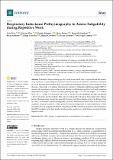Respiratory Inductance Plethysmography to Assess Fatigability during Repetitive Work
Author(s)
Silva, Luís; Dias, Mariana; Folgado, Duarte; Nunes, Maria; Namburi, Praneeth; Anthony, Brian; Carvalho, Diogo; Carvalho, Miguel; Edelman, Elazer; Gamboa, Hugo; ... Show more Show less
Downloadsensors-22-04247-v3.pdf (3.345Mb)
Publisher with Creative Commons License
Publisher with Creative Commons License
Creative Commons Attribution
Terms of use
Metadata
Show full item recordAbstract
Cumulative fatigue during repetitive work is associated with occupational risk and productivity reduction. Usually, subjective measures or muscle activity are used for a cumulative evaluation; however, Industry 4.0 wearables allow overcoming the challenges observed in those methods. Thus, the aim of this study is to analyze alterations in respiratory inductance plethysmography (RIP) to measure the asynchrony between thorax and abdomen walls during repetitive work and its relationship with local fatigue. A total of 22 healthy participants (age: 27.0 ± 8.3 yrs; height: 1.72 ± 0.09 m; mass: 63.4 ± 12.9 kg) were recruited to perform a task that includes grabbing, moving, and placing a box in an upper and lower shelf. This task was repeated for 10 min in three trials with a fatigue protocol between them. Significant main effects were found from Baseline trial to the Fatigue trials (<i>p</i> < 0.001) for both RIP correlation and phase synchrony. Similar results were found for the activation amplitude of agonist muscle (<i>p</i> < 0.001), and to the muscle acting mainly as a joint stabilizer (<i>p</i> < 0.001). The latter showed a significant effect in predicting both RIP correlation and phase synchronization. Both RIP correlation and phase synchronization can be used for an overall fatigue assessment during repetitive work.
Date issued
2022-06-02Department
Massachusetts Institute of Technology. Institute for Medical Engineering & Science; Massachusetts Institute of Technology. Department of Mechanical EngineeringPublisher
Multidisciplinary Digital Publishing Institute
Citation
Sensors 22 (11): 4247 (2022)
Version: Final published version